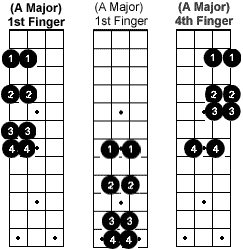« Compose yourself. Course correction. |
Main
| Seamless shifting »
 July 15, 2010 | Moving on up. And around. July 15, 2010 | Moving on up. And around.

Think of what it is to learn to speak a language. We learn the words we need to survive, including words for food and comfort. We start with primal concepts, and then we work our way up to more complex thoughts combining these into nouns and verbs that express actions and more sophisticated needs. we learn phrases and the proper way to string them. Really, we get to the point where it's more about the string than the individual word. We get to where we aren't as conscious about how they are strung, and that frees us up to come up with more descriptive words that pack deeper meaning and communicate exponentially more powerfully. Maybe and occasional grammar correction, but by the time we are adults, we are well established in how we talk and write. It becomes very much unconscious.
Playing an instrument is like this. We learn where the notes are when starting out. Then we learn scales to more effectively string them together. We learn the conventions of major, minor, and other modes, where the half-steps and whole-steps are within the sequence, eventually getting to the point where these are automatic, too. When we tackle higher level improvisation, it's a wonderful combination of intuition and calculation, and tons of blurry stuff in between.
If you've messed around with our FFcP approach to fretboard familiarity, you've started on some building blocks that can bring huge payoffs in the future. Once these are mastered in the resident one-octave format however, it's time to REALLY expose their complex advantage not only in movability, but range. The next step is to do TWO octave scales, and not necessarily in the same area of the fingerboard.
We identify this in a Mandolin Cafe Lesson, as well as in the Getting Into Jazz Mandolin book. The idea is once you've got a basic grip on the four basic FFcP fingerings, it's time to move them around and better, connect them with FFcP patterns up and down the neck.

We've written a great exercise for you to start doing this. It's a good idea to just get these into your fingers, and work on smooth connection, making it sound like the same passage, even with a jump. That's not easy to do effectively, but the more you work at it, the more you'll be able to exploit the entire range of the fretboard. When you've messed around with this a while, try connecting other FFcP patterns, not just the scales but the arpeggios, 3rds, and 4ths while moving them to other regions of the fingerboard. Work on bridging them seamlessly, no detectable bump in sound or sustain when you shift.
Enjoy 2 Page PDF:  Moving on Up Moving on Up
Further:
Moving Horizontally
Patterns Overboard.
Leading Off Third Base: The benefits of third position fingering.
New ways of looking at old scales
How we learn
Posted by Ted at July 15, 2010 7:00 AM

Disclaimer: In the 'Information Age' of the 21st Century,
any fool with a computer, a modem, and an idea can
become a self-professed 'expert." This site does not
come equipped with 'discernment.'
|



